In the aftermath of devastating floods, Kazakhstan and Russia are dealing with the consequences of rising river water levels. Cities in the southern Ural Mountains and western Siberia remain on high alert as the situation remains critical. Both Astana and Moscow described the floods as the worst in decades, leading them to declare a state of emergency.
Meanwhile, Indonesia experienced a 6.6-magnitude earthquake on the Moluccas Islands in eastern Indonesia, according to the American Seismological Observatory. Although no tsunami warnings were issued, authorities closely monitored the situation for potential further flooding. More than 100,000 people were evacuated in Kazakhstan, with over 86,000 already rescued and evacuated. Thousands of animals were also transported to safety.
In Russia, over 6,500 people were evacuated due to rapidly rising Ural and Tobol rivers threatening Orenburg and Kurgan. The water levels were at critical points as authorities closely monitored the situation for potential further flooding. The Kremlin announced that President Vladimir Putin was closely monitoring the situation and working on relief efforts but had no immediate plans to visit the affected areas.
Amid these natural disasters, disaster preparedness and response measures have been highlighted as crucial to ensuring the safety and well-being of all affected individuals.
Overall, natural disasters continue to pose a threat to many regions around the world. As governments work tirelessly to respond to these events and protect their citizens from harm, it is essential that we prioritize disaster preparedness efforts to minimize damage and save lives.
The government must invest in early warning systems and emergency response plans that can quickly mobilize resources when needed. Additionally, there must be increased cooperation between governments at all levels to ensure that resources are shared effectively across borders.
As individuals living in affected areas, we must do our part by staying informed about potential threats and taking necessary precautions such as evacuating when advised or seeking higher ground if possible.
By working together at all levels – from governments to communities – we can reduce our vulnerability to natural disasters and help ensure a safer future for ourselves and future generations.
In conclusion, while natural disasters continue to pose a threat around the world, it is crucial that we prioritize disaster preparedness efforts at all levels – from governments investing in early warning systems and emergency response plans to individuals taking necessary precautions when needed. By working together effectively at all times, we can reduce our vulnerability to these events and help ensure a safer future for ourselves

